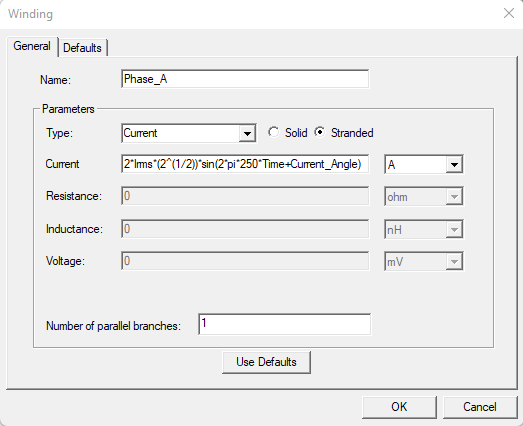-
-
March 21, 2022 at 5:10 am
ericwu
SubscriberHi, everyone:
I'm designing a PMSM motor using Ansys Maxwell, I got some questions as I setting the winding excitation:
- What's the difference between current and voltage type of excitation, why it's not allow users to enter the winding inductance and resistance in current type of excitation?
- If I use current type of excitation, what voltage do I get in "inducedvoltage" of transient report? Is it only the back EMF from magnets?
- How can I plot the winding voltage included inductance voltage and resistance voltage drop in transient report?
Thank you.
March 25, 2022 at 1:02 pmNKC
Forum Moderator
1) For voltage source since Maxwell needs to calculate the current for computing the field quantities we need to input the resistance. The inductance that you enter here is the end winding inductance only in the case where the whole winding is not modeled, like in 2D. In 3D, if you model the complete winding you can input zero for the same. In the case of current, you need not input the resistance as fields can be computed from the current.
2) Induced voltage is the combination of Inductance voltage due to flux linkage + Backemf.
3) I do not think it can be achieved directly in Maxwell (At least I don't know how to do that).
Regards Navya
April 5, 2022 at 4:29 pmHDLI
Ansys Employee
For 3, we could use external circuit with resistance or inductance and voltage meter, to measure total voltage of inductance, resistance and BackEMF, that can be plotted in the transient report.
HDLI
Viewing 2 reply threads- The topic ‘Induced voltage in Maxwell’ is closed to new replies.
Ansys Innovation SpaceTrending discussions- Lumped Port Deembed
- Hfss 3D pcb via capped and filled with epoxy
- Optimizing Via Impedance in Ansys HFSS 3D Layout Using Geometric Parameter Sweep
- HFSS libnvidia-ml.so too old or could not be found – Warning in slurm job output
- AEDT Natural Convection with default correlation is failing solver initializatio
- STL Import Errors in HFSS After Cleaning in SpaceClaim
- Three-Phase Voltage Imbalances in dual stator electric generator
- Calc Error in Field Calculator after PyAEDT Analyze
- import file autocad 3d
- Co-simulation in Q3D, Icepak – meshing problem
Top Contributors-
3977
-
1461
-
1272
-
1124
-
1021
Top Rated Tags© 2025 Copyright ANSYS, Inc. All rights reserved.
Ansys does not support the usage of unauthorized Ansys software. Please visit www.ansys.com to obtain an official distribution.
-
The Ansys Learning Forum is a public forum. You are prohibited from providing (i) information that is confidential to You, your employer, or any third party, (ii) Personal Data or individually identifiable health information, (iii) any information that is U.S. Government Classified, Controlled Unclassified Information, International Traffic in Arms Regulators (ITAR) or Export Administration Regulators (EAR) controlled or otherwise have been determined by the United States Government or by a foreign government to require protection against unauthorized disclosure for reasons of national security, or (iv) topics or information restricted by the People's Republic of China data protection and privacy laws.












